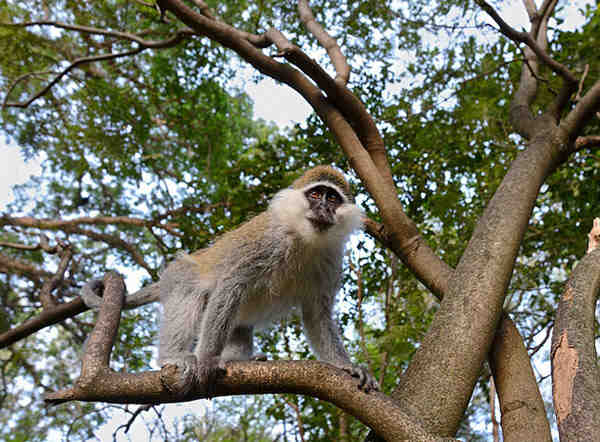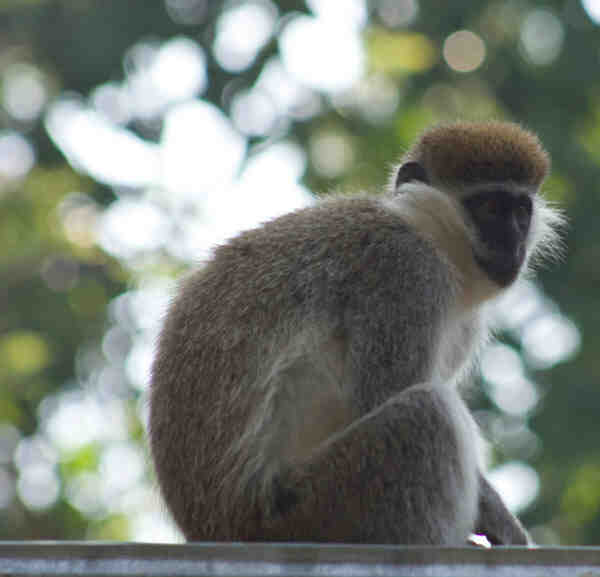Chlorocebus sabaeus
IUCN
LCBasic Information
Scientific classification
- name:Chlorocebus sabaeus
- Scientific Name:Chlorocebus sabaeus,Grivet Monkey,Tantalus green monkey, Steppe green monkey
- Outline:Primates
- Family:Cercopithecidae G.Monkey
Vital signs
- length:60-80cm
- Weight:3-5kg
- lifetime:About 13 years
Feature
The whole body is covered with thick golden fur with green hues, and the face is black.
Distribution and Habitat
Distributed in Djibouti, Eritrea, Ethiopia and Sudan.
The black-faced green monkey lives in tropical savannah areas near rivers and streams, and prefers to move around in tree-filled areas. Although black-faced green monkeys prefer specific environmental conditions, they can easily adapt to a variety of habitats. In Africa, black-faced green monkeys live in grassland areas in southern Sudan and the Abyssinian highlands. Black-faced green monkeys must also drink water every day during the dry season, so their habitat is limited to those places that are close to a constant water source.
Appearance
The black-faced green monkey is a medium-sized monkey, weighing 3-5 kg and 600-800 mm long. The whole body is covered with thick golden fur with green tones. The cheeks are hairless, but covered with soft white hair around them, highlighting the outline of the black skin. Like other monkeys, they have a slender tail. Males and females are dimorphic. The scrotum of males is blue, and the penis is obviously red. The color combination presents a distinct "red, white, and blue" display.
The snout is prominent, the two jaws are strong, there are 32 teeth, the nostrils are close together facing forward and downward, and the hands and feet have 5 fingers and toes, with flat nails, and can all stand upright. It is diurnal. It has cheek pouches for storing food, low-pointed teeth, and a relatively mixed diet. Usually, the limbs are basically equal in length.
Details
Black-faced green monkey (scientific name: Chlorocebus sabaeus) is also known as Grivet Monkey in English. There are 3 subspecies.

Black-faced green monkeys often move on the ground. They are gregarious. They are good at climbing, running, and swimming. The populations vary widely, with groups ranging in size from 7 to 80 individuals. Female green monkeys stay in the family group when they reach sexual maturity, while adult males leave the family. This helps avoid inbreeding and increases the spread of desired genes. Green monkeys have overlapping territories in many habitats. Male green monkeys fight or display their scrotums to determine dominance, and social hierarchy determines how much resources teammates get. The big brother of the green monkey restricts other males and females from mating and defends his territory, fighting back against males from other tribes entering his tribe. Such encounters are usually limited by environmental conditions and resource availability. Territorial violations only occur when food is scarce or habitat is becoming increasingly scarce.
Green monkeys are highly social animals. Like to live in groups, they are very smart animals. Usually, group members often use ways such as raising eyebrows, squinting eyes, and pouting to communicate emotions. Black-faced green monkeys, like other monkeys, often groom each other and like to "catch lice" for each other to show intimacy. Usually, male monkeys groom male monkeys, and female monkeys groom female monkeys. It is rare for the two sexes to "catch lice" for each other. In the breeding season, males and females groom each other, which is a sign of intimacy between spouses.
Black-faced green monkeys are very vocal primates. Vocalization is mainly to alert members of the tribe that there is danger. Black-faced green monkeys can use different calls to distinguish various enemies and danger levels, and males can also communicate through body language. Use brightly colored genitals. Or use more subtle communication methods through facial expressions. Studies have shown that facial expressions are related to emotional states. Anger, elation, and even emotional frustration show different facial expressions. Vervets use facial expressions to indicate danger or satisfaction, depending on the situation.
In the wild, Vervets have different screams for different dangers, one that might indicate a leopard is lurking nearby, another that might indicate a human is threatening it. Because they live in the jungle shaded by leaves, they can hear each other's screams but cannot see each other, so they also need to be able to distinguish accents. Vervets from different families have subtle differences in their accents, which is important, for example, a female animal will definitely rush to rescue her cubs more quickly when hearing the cries for help than when hearing the cries of other species.

The black-faced green monkey feeds mainly on fruit and leaves. Food resources depend on the year and environmental conditions. During the dry season or after a fire, when only a small amount of fruit can be found, the black-faced green monkey will forage for edible plants throughout the grassland, including grass leaves and roots that have little nutrition. However, when there is sufficient rain and fruit becomes more abundant, it is common to collect fruit, including wild bananas, papayas and mangoes. In the wild, green monkeys usually use cheek pouches to store and carry food. These cheek pouches are present in all members of the monkey family. This behavior protects them from retaining precious food and allows the green monkeys to continue to collect food for longer periods of time.
The social structure of the green monkey is male-dominated and is a polygamous mating system. The breeding season is from April to June. Usually the area where the green monkeys live enters a heavy rainfall pattern. The abundant rainfall provides an ample source of food and also causes an exponential increase in nutritional resources. This special breeding season is adapted to the advantages of abundant resources. Reproduction occurs once a year. Females reach sexual maturity at 2 years and males at 5 years. From birth, female monkeys carry their offspring closely on their bodies. The time of caring for the young is about 1 year until they are fully weaned and independent. The lifespan in captivity is about 11-13 years.
The black-faced green monkey is a highly frugivorous animal, which plays a great role in the entire ecosystem and the dissemination of plant seeds. In addition, their diet is mainly herbivorous, which does not compete with insects, birds, bats and other primate species. The large population density of black-faced green monkeys makes them a food source for many carnivores. Natural enemies include African cats and raptors, and sometimes baboons will also catch black-faced green monkeys. Parasites are common in black-faced green monkeys. The most common ones in wild black-faced green monkeys are protozoan parasites and worms, which are troubles and pests faced by black-faced green monkeys.
Listed in the 2008 Red List of Endangered Species of the World Conservation Union (IUCN) ver 3.1-Least Concern (LC).
Protect wild animals and stop eating game.
Maintaining ecological balance is everyone's responsibility!








